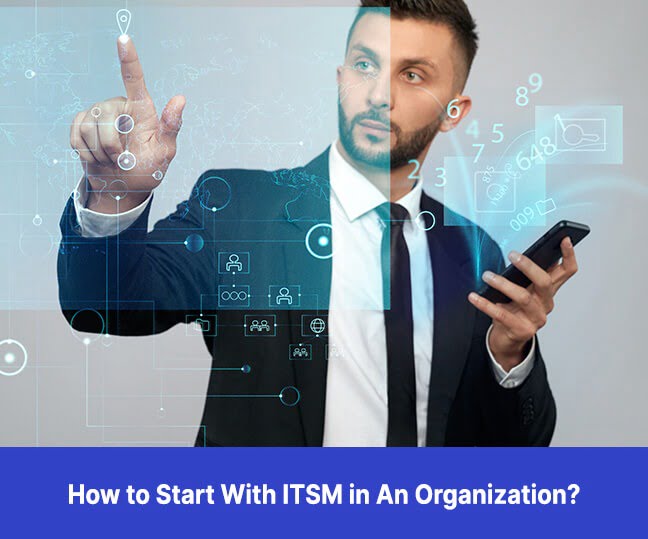IT Service Management (ITSM) has become essential to any organization’s success in today’s technologically advanced environment. Organizations frequently rely on a broad ecosystem of vendors and providers when sourcing the hardware, software, and other essential components needed to maintain and improve their IT infrastructure. ITSM professionals need to create efficient vendor and supplier management techniques to guarantee the profitability and efficiency of these relationships.
Vendor and supplier management within ITSM refers to an organization’s processes and activities to establish and maintain productive and mutually beneficial relationships with external partners who provide products, services, or resources essential for its IT operations. These partners can include hardware and software vendors, cloud service providers, consulting organizations, and more. This blog will explore vendor and supplier management within ITSM, stressing its importance, best practices, and potential business advantages.
Related article: A Comprehensive Guide on ITSM Tool Evaluation and Selection
What is Vendor Management?
Vendor management refers to the collection of processes and actions undertaken by an organization to oversee and regulate its connections with external vendors or suppliers. These vendors can provide a variety of commodities, services, or resources necessary for the organization’s operations, initiatives, or services. Vendor management ensures that these external alliances are strategically aligned, and profitable, and help the organization achieve its goals and objectives.
How can Vendor Management Drive Service Excellence?
Vendor management is critical in promoting service quality inside an organization. By controlling and partnering with external vendors or suppliers, an organization can improve its overall service delivery and customer satisfaction. Here are a few ways that vendor management can help with service excellence:
Specialized Knowledge and Expertise: Vendors frequently bring specialized skills, knowledge, and expertise. Organizations can tap into this knowledge to produce high-quality services they need help achieving in-house by carefully selecting vendors with the necessary competencies.
SLAs (Service Level Agreements): Clear SLAs must be established with vendors as part of vendor management. These SLAs outline the performance criteria, turnaround timeframes, and quality requirements. Services are routinely delivered at a high level of quality by meeting or exceeding certain SLAs.
Optimizing Resources: Organizations can distribute their internal resources more efficiently thanks to vendor management. Organizations can use suppliers to handle specific tasks instead of devoting time and energy to activities outside their core expertise, freeing internal teams to concentrate on strategic objectives.
Scalability: Vendor scalable solutions enable businesses to modify their service capabilities in response to shifting demand. This scalability guarantees that services remain reliable and adaptable even during expansion or demand changes.
Risk Mitigation: A key component of efficient vendor management is identifying and mitigating potential hazards related to vendor relationships, such as supply chain interruptions or security flaws.
Compliance and Quality Assurance: Vendor management ensures vendors follow legal and ethical guidelines. The intended service quality and compliance level are maintained with the help of routine audits and assessments.
Flexibility: Vendor connections give you options for different types of services. Organizations can customize and be flexible by selecting the finest vendor from a variety to meet their unique service needs.
What are the Steps of Vendor Management?
Vendor management entails many steps to build and sustain successful partnerships with external vendors or suppliers. These steps aid businesses in ensuring that their vendor relationships are advantageous to their operations, profitable, and strategically aligned. The following are the main steps in managing vendors:
1. Selection and Assessment of the Vendor:
- Depending on your organization’s needs, determine whether you need external vendors or suppliers.
- Compile a list of potential vendors using industry suggestions, research, and referrals.
- Consider variables including competencies, experience, financial stability, reputation, and alignment with the principles and aims of your organization when evaluating providers.
- Verify the vendor’s credentials by performing due diligence checks, such as background and reference checks.
2. Contract Negotiation:
- Negotiate a contract that specifies the terms and outlines the relationship once a suitable vendor has been found.
- Specify the duties, deadlines, deliverables, and service levels required of the provider.
- Include clauses in the contract that deals with pricing, payment terms, warranties, dispute resolution procedures, and departure plans.
- Make sure the agreement conforms with all relevant laws and regulations and is legally sound.
3. Performance Metrics and Monitoring
- Establish measurements and Key Performance Indicators (KPIs) that support the objectives of the vendor relationship.
- Establish precise guidelines for performance, quality, response times, and other important considerations.
- Review progress at the planned performance assessments and routinely check vendor performance against these parameters.
- Develop a cooperative and pleasant relationship with the vendor based on openness and trust.
- Establish measurements and Key Performance Indicators (KPIs) that support the objectives of the vendor relationship.
- Establish precise guidelines for performance, quality, response times, and other important considerations.
- Review progress at the planned performance assessments and routinely check vendor performance against these parameters.
- Develop a cooperative and pleasant relationship with the vendor based on openness and trust.
4. Risk Management:
- Supply chain disruption, data breaches, or financial instability are potential hazards to the vendor relationship.
- To deal with these hazards, create risk mitigation methods and emergency plans.
- To ensure business continuity, evaluate risk management plans frequently and change them as necessary.
5. Compliance and quality assurance:
- Ensure the seller follows all applicable laws, rules, and industry standards.
- Conduct routine audits and assessments to ensure compliance with and adherence to quality standards.
- Immediately address any non-compliance issues and collaborate with the vendor to implement corrective measures.
6. Cost management and efficiency:
- Evaluate the costs of the vendor relationship regularly.
- Look for possibilities to bargain for better terms, reduce wasteful spending, and maximize resource usage.
- To ensure correctness and promptness, monitor vendor invoices and payments.
- Request process innovations, improvements, and cost-cutting ideas from vendors.
- Work with the provider to implement changes to improve the caliber and effectiveness of the services offered.
7. Exit Strategy:
- Create a clear exit strategy if the vendor relationship needs to be ended, changed to a different vendor, or moved to an internal solution.
- To reduce interference with your organization’s operations, ensure a seamless transfer process.
- Keep thorough records of all vendor-related paperwork, including contracts, performance reviews, letters, and audits.
How can Vendor Management Help Organizations Reduce IT Costs?
The first method of cost reduction through vendor management is careful vendor selection. Before choosing and approving any vendors, set your goals to ensure you understand how you want to balance cost and quality. It will assist you in concentrating your vendor-management actions on cost reduction if cutting IT costs is your primary motivation. Establishing vendor contracts can be managed to ensure cost control is essential for cost reduction. Businesses without efficient methods for managing their vendors may quickly learn that their suppliers strive to charge more for services they initially believed were covered by the contract.
By actively ensuring you are paying for what vendors are delivering, vendor management can assist an organization in cutting expenses. One example is a long-term contract where a vendor agrees to upgrade its IT technology as the technologies advance. Vendors may only fulfill their commitments to save costs if your vendor management operations verify that this is happening. Additionally, vendor management can help you avoid tasks that vendors are supposed to perform because you were unaware of the specifics of your vendor contracts or handled them poorly.
What are the benefits of vendor management?
- Improved client Satisfaction: Ensuring the services meet or surpass client expectations leads to higher customer satisfaction.
- Enhanced Service Quality: Vendor management improves service quality by monitoring and holding vendors accountable, assuring consistency and reliability.
- Improved Vendor Services: Proactive management of vendor relationships encourages vendors to match their services with the needs and goals of your organization.
- IT Goal Attainment: Vendor management is crucial in meeting IT objectives and project milestones by ensuring vendor performance aligns with project requirements.
- Cost Reduction: Effectual vendor management can save money by optimizing vendor contracts, reducing overbilling, and improving cost control.
- Budget Achievement: While quantifying the exact impact on the IT budget is difficult, vendor management aids in budgetary achievement by optimizing vendor-related spending.
- Accountability for Failures: If vendors fail or have problems, customers may place all the blame on the organization if there is weak vendor management or poor execution.
- Rapid Issue Resolution: Vendor management speeds up issue and incident resolution, reducing service disruptions and increasing operational performance.
- Customer Satisfaction Maintenance: Maintaining high customer happiness directly results from excellent vendor management, which reduces disruptions and assures service reliability.
Categorizing Vendors for Effective Management:
Understanding that there are various sorts of vendors, each requiring a distinct level of supervision, is essential for success in vendor management. Handling every vendor, in the same way is unsuccessful, which is a monolithic approach to vendor management. Your strategy for vendor management must initially establish distinct categories under the various IT services, products, and levels of business criticality. Let’s delve into these vendor categories below:
Regular/Standard Vendors:
Standard or regular vendors provide services based on standard applications configurable by the customer. Because it is considerably easier to change a vendor in this category, vendor management for this category should be customized to recognize these vendor features. However, if the services and goods are vital to your organization, your vendor management should strive to keep the vendor by developing a long-term relationship with them.
Integration Specialists Vendors:
Integration specialized vendors offer services tailored to managing the seamless integration of diverse technology products and services. Given the customized nature of these integrations, your vendor management strategy for this category should prioritize retaining these vendors, as they are likely to play a crucial role in your business operations and could prove challenging to substitute.
Standard Commodity Vendors:
These vendors offer products or services that are readily available and lack extensive customization options, making them fall under the category of standardized service providers. This approach could be as straightforward as implementing management controls for essential commodity vendors to ensure timely payments, thereby safeguarding the continuity of vital services, such as wide area network connectivity.
Custom Solution Vendors:
These vendors specialize in developing products and services that match your requirements. It involves outsourcing, in which a third-party entity assumes responsibility for previously developed internal applications and services. It also includes managed service offerings, in which the vendor provides services based on predetermined service levels and providers who design applications to your exact specifications.
What is Supplier Management?

Supplier Management comprises the entirety of business processes and actions associated with a supplier’s lifecycle within an organization. These processes contain various activities, such as identifying, selecting, and overseeing pertinent suppliers and thoroughly evaluating their performance to ensure optimal value is derived for the organization’s third-party needs. Efficacious supplier management assists organizations in the following ways:
- Ensure alignment with the organization’s aims and values.
- Reduce costs and increase competence in supplier relationships.
- Improve the quality of their suppliers’ products and services.
- Reduce the risk of supplier performance and compliance.
- Increase innovation and competitiveness by collaborating with suppliers.
- Develop long-term, mutually beneficial partnerships with your suppliers.
The Objective of Supplier Management
Supplier management has several key objectives:
1. Relationship Management: Operatively manage relationships with various suppliers and continuously monitor their performance, maintaining accurate records of these interactions.
2. Policy Establishment: Establish and maintain a clear policy regarding suppliers while supporting it with a Supplier Contract Management Information System.
3. Optimize Cost Efficiency: Ensure the organization gets the best possible value for the money spent on all suppliers and contracts.
4. Alignment with Business Needs: Ensure that underpinning contracts (UCs) and agreements with suppliers align with the organization’s business requirements and agreed-upon objectives.
5. Contract Lifecycle Management: Negotiate contracts with suppliers, finalize agreements, and oversee their management throughout their entire lifecycle.
Related article: Do you work as an MSP? Here’s why you should invest in an RMM solution.
Scope of Supplier Management:
Supplier management confines overseeing all suppliers and contracts essential for supporting IT services. This supplier management process serves as a centralized mechanism for the comprehensive review and management of each supplier, with each supplier being assigned an individual owner for practical oversight and collaboration. This process acknowledges the significance of each supplier’s contribution and focuses on cultivating and maintaining a robust relationship with them to uphold their valuable contributions.
Supplier Management Process Activities:
Defining Business Goals and Objectives:
1. Identify Business Goals: The specific business goals and objectives require supplier involvement.
2. Align with Departments: Ensure each department’s external sourcing requirements are clearly defined, enabling a precise vendor selection process without unnecessary time and cost.
3. Performance Benchmark: These established goals are benchmarks for evaluating supplier performance and ensuring alignment with the suppliers’ expectations.
Selecting Supplier Criteria:
- Define Objectives: Understand the organization’s goals and requirements necessitating supplier engagement.
- Specify Selection Criteria: Clearly outline the criteria for evaluating and choosing suppliers who best fulfill the requirements.
- Diverse Criteria: Consider various factors, such as cost, prior work quality, industry reputation, legal standing, and more, tailored to the organization’s and suppliers’ needs.
- Utilize RFQs, RFPs, and RFIs: Employ Request for Quotation (RFQs), Request for Proposal (RFPs), and Request for Information (RFIs) when stringent specifications require a thorough vendor selection process.
Assessing New Suppliers:
The following processes are executed to evaluate new suppliers and contracts for alignment with the needs of the organization:
- Determine Procurement Approach: Identify the procurement method to be employed.
- Define Evaluation Criteria: Establish criteria for assessing the product or service.
- Explore Available Alternatives: Evaluate the available alternatives.
- Opt for the Preferred Alternative: Select the most advantageous option based on the evaluation.
Categorizing Suppliers and Contracts:
- Evaluate Suppliers and Contracts: Assess suppliers and their associated contracts.
- Implement Changes in Service Transition: Ensure necessary changes are implemented during the service transition phase.
- Categorize Suppliers: Organize suppliers into appropriate categories based on specific criteria.
- Update Supplier and Contract Database: Maintain and regularly update the Supplier and Contract Database.
- Database Maintenance: Continuously oversee and manage the Supplier and Contract Databases for accuracy and relevance.
Establishing New Suppliers:
- Policy Adherence: Align with the organization’s policy to onboard new suppliers and contracts.
- Supplier Service and Contract Setup: Create the necessary supplier service and contract structures.
- Service Transition Preparation: Prepare for a smooth transition to the new service.
- Establish Contacts and Relationships: Forge connections and relationships with the newly onboarded suppliers.
Related blog: The Ultimate IMACD Process Guide for Seamless Transitions in 2023
Managing the Contract:
- Operational Oversight: Manage and control the operation and delivery of the contracted service or product.
- Quality and Cost Monitoring: Monitor and report on service quality and associated costs.
- Service Enhancement: Continuously review and improve the service to optimize its performance.
- Supplier Relationship Management: Foster and manage the relationship with the supplier, ensuring sufficient collaboration.
- Contract Renewal or Termination Planning: Strategize for potential contract renewal or termination, considering future needs and performance evaluations.
Renewing or Terminating Contracts:
- Renewal Assessment: Consider contract renewal if the supplier consistently delivers favorable service quality.
- Termination Evaluation: Explore contract termination if service quality proves unfavorable or no longer meets the organization’s needs.


















